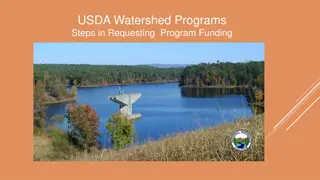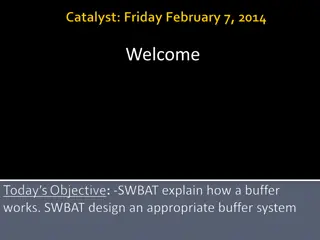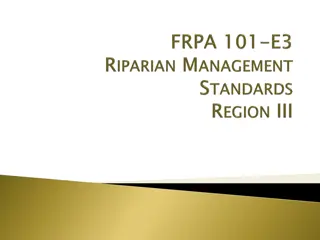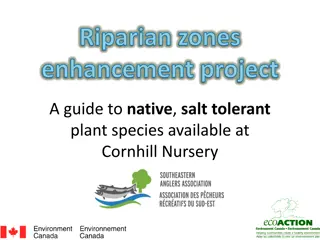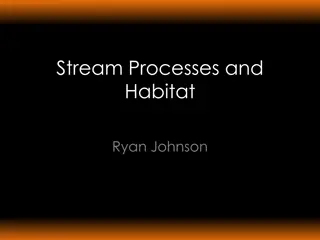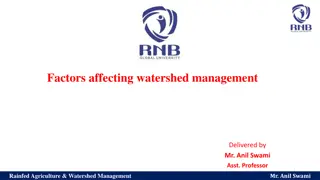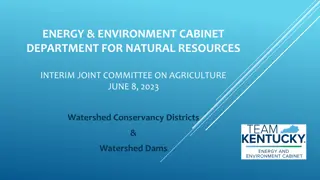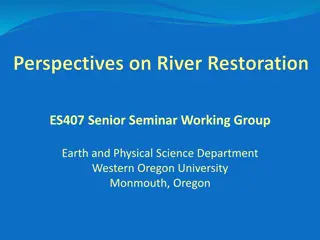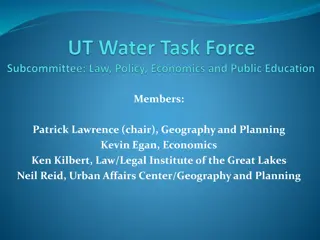Optimizing Riparian Buffers for Thermal Protection in Teanaway River Watershed
Explore the study comparing optimized riparian buffer designs with fixed-width buffers in non-fish bearing streams of the Teanaway River watershed, focusing on maximizing thermal energy reductions with considerations for channel orientation and forest density. By utilizing NetMaps and thermal energy calculations, the research aims to determine the optimum buffer widths for protecting against increases in thermal energy, shedding light on the importance of stream orientation and vegetation characteristics in effective thermal protection strategies.
Download Presentation

Please find below an Image/Link to download the presentation.
The content on the website is provided AS IS for your information and personal use only. It may not be sold, licensed, or shared on other websites without obtaining consent from the author. Download presentation by click this link. If you encounter any issues during the download, it is possible that the publisher has removed the file from their server.
E N D
Presentation Transcript
Optimizing Riparian Buffers for Thermal Protection TerrainWorks (www.terrainworks.com)
We ask the question: What is the optimum design and width of riparian buffers to protect against increases in thermal energy and how does that compare to fixed with buffers in headwater streams?
To answer that question, we employ NetMapsvirtual watershed that evaluates thermal load that is sensitive to solar angle, latitude, topography, channel width, channel orientation and streamside vegetation height and density.
Background Most thermal buffer rules are based on policy negotiations aimed at balancing thermal protection with forest economic values (timber harvest). Regardless of policy negotiations, most buffer width dimensions are based on studies and literature that have identified threshold buffer widths using stream temperature field measurements and or modeling. The general rule of thumb is that buffers between 75 and 100 feet are necessary to ensure thermal loading protection. In general, no consideration is given to stream orientation that strongly influences thermal energy to streams, including left and right side of the channel. Field studies that identify buffer width thresholds cannot, for practical reasons, consider the full variability of channel characteristics. Here, we use a thermal energy calculation to help understand the design of optimized buffer widths.
Project area: Teanaway River watershed in the Yakima River basin, eastern Washington; analysis limited to non fish bearing streams less than 10 km2 (2470 acres) in area. Study Area
In the Teanaway River watershed in eastern Washington, we compare a few different riparian buffer designs on headwater, non fish bearing streams (approx. 14,370, 100 m reach segments): 1) Optimized buffer widths that maximizes thermal energy reductions and that differentiates right and left sides of channels (looking downstream) and accounts for varying azimuth, 2) Fixed with buffers at widths of 25 ft, 50 ft, 75 ft and 100 ft (same on both sides of the channel); 3) We use a density of riparian forests of 70% (can be varied) to calculate light transmission using a physically based model of thermal loading; the model incorporates Beers Law , a common approach in thermal loading models (density is a function of leaf area index, DeWalle 2010). DeWalle, D. 2010. Modeling stream shade: riparian buffer height and density as important as buffer width. Journal of American Water Resources Association. 1-11:1752-1688.
Channel direction or azimuth (0 360 deg) matters: N-S oriented streams require similar buffer widths on both sides of the stream; whereas, E-W oriented streams have less buffer width on the north side of the channel.
The attenuation of solar radiation with buffer width is governed by a power law (Beers Law) Solar radiation less and less light radiation comes into the stream with increasing distance from the stream within a buffer (watt-hours m ) -2 Buffer width
There is a rapidly diminishing effectiveness of increasing buffer width on radiation protection (sketch) 100% Radiation Protection Cumulative Solar 75% (watt-hours m ) -2 50% 25% 200 150 100 50 Buffer width (ft)
Optimized buffers - analysis approach 1) calculate bare Earth radiation (maximum), 2) calculate maximum possible radiation reduction or protection (500 m forest width, density = 0.7), 3) specify a percent reduction in radiation (25%, 50%, 75%, 90%, 95%, 99%) between bare Earth and the maximum reduction. Bare Earth Solar radiation (watt-hours m ) -2 Maximum reduction Example 90% X ft Buffer width Specify % protection
Here is a mapped example of model outputs: Optimized buffers are less wide on the north sides of streams along east west flowing channels little difference in north sound trending streams
The next three slides illustrate the effects of stream orientation (azimuth) on left and right buffers at three levels of thermal loading protection: 80%, 90% and 99%; observe the y axis differences in left-right buffer widths
Optimized Buffer width (left-right) versus channel azimuth (80% protection) Average tree ht = 25 m (82 ft); density = 0.7
Optimized Buffer width (left-right) versus channel azimuth (90% protection) Average tree ht = 25 m (82 ft); density = 0.7
Optimized Buffer width (left-right) versus channel azimuth (99% protection) Average tree ht = 25 m (82 ft); density = 0.7
Comparison of optimized versus fixed with buffers, percent protection and area required Prescription Protection (%) Area (acres) Percent change of fixed width area to optimized buffer areas at 95%, 98% and 99%, respectively +37% +65% 95% 98% 99% 6,780 9,315 11,228 Optimized, Left-right -23%1 -43% -53% 91% 5,219 Fixed width 25 ft 98% 10, 428 +54% +12% -7% Fixed width 50 ft 99.7% 15,657 +130% +68% +39% Fixed width 75 ft 99.9% 20,874 +207% +124% +86% Fixed width 100 ft 1 ((5,219-6,780)/5,219)*100
Comparing an optimized buffer to a fixed width 50 ft buffer Prescription Protection (%) Area (acres) Percent change of fixed width area to optimized buffer areas at 95%, 98% and 99%, respectively +37% +65% 95% 98% 99% 6,780 9,315 11,228 Optimized, Left-right 91% 5,219 -23% -43% -53% Fixed width 25 ft 1 98% 10, 428 +54% +12% -7% Fixed width 50 ft 99.7% 15,657 +130% +68% +39% Fixed width 75 ft 99.9% 20,874 +207% +124% +86% Fixed width 100 ft Matching an optimized buffer design to a protection level equal to that of a fixed width 50 ft buffer decreases the area under the buffer by 12% and ensures that 98% is the minimum protection under the fixed 50ft, there will be reaches that will not meet that minimum protection (e.g., protection improvement) 1 ((10,428-9,315)/9,315)*100
The optimized left-right buffer with a protection equivalent to a fixed 50 ft buffer
The amount of thermal protection afforded by incrementally increasing buffer width rapidly diminishes with increasing absolute buffer width and the area encompassed by the buffer.
Predicted buffer width vs % protection is very sensitive to vegetation density term; reducing vegetation density to 0.50 yields 90% reduction for a 50ft buffer (rather than 98% with a 0.7 density) and a 75 ft and 100 ft buffer yields only 93.5% and 94% protection; the key here is to determine what the natural density of the riparian forest vegetation is and then use that as the baseline for all analyses and resulting buffer prescriptions (changing vegetation density will not change the results shown in this PPT).
Possible buffer strategies: 1) optimized (designer) buffers, select % protection, by tree height and density left, right buffer dimensions vary by channel segment azimuth etc. create channel maps of optimized protection, apply reach by reach; 2) use optimized buffers to match some level of fixed with buffer protection (which will increase the effectiveness above many fixed with buffers, for example, the 50 ft fixed with buffer shown in this PPT); 3) for headwater non fish streams, select % protection based on probability of being seasonal vs non seasonal; 4) GIS based analysis will never be truly accurate with regards to channel orientation, channel width and tree height thus build a field based approach using a Tablet and or collect field data and re-calculate in the office (see next).
Improve accuracy of optimized buffer designs









